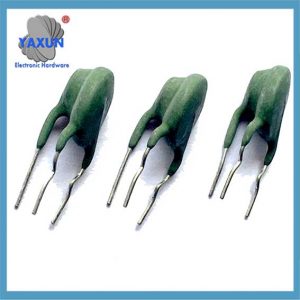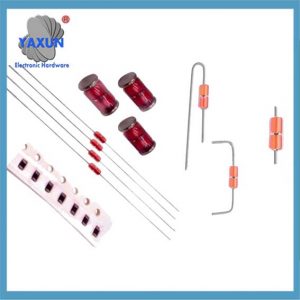Termistörler, direnç değeri sıcaklıkla değişen özel dirençlerdir.. Bu tip direnç, çeşitli sıcaklık algılamalarında yaygın olarak kullanılır, sıcaklık kontrolü, termal koruma ve diğer durumlar. Termistörlerin temel ilkelerini ve kalitelerini nasıl değerlendireceklerini anlamak, ilgili endüstrilerdeki elektronik tutkunları veya işçiler için çok gereklidir..
Termistör nedir?
Termistör, direnç değeri sıcaklıkla değişen ve sıcaklık algılama için kullanılan bir dirençtir., Kontrol ve termal koruma. Bir termistörün iyi mi yoksa kötü mi olduğunu yargılamak, Görünüşü kontrol etmelisin, direnç değeri, Direnç değişikliği ve tepki hızı. Termistörleri seçerken ve kullanırken, Uygulama senaryolarını ve koşullarını göz önünde bulundurmanız gerekir, Sert ortamlardan kaçının, ve işletme özelliklerini takip edin.
Birinci, Termistörlerin temel ilkelerini anlayalım. Bir termistörün direnç değeri sıcaklıkla değişir, Bu onu çok hassas bir sıcaklık sensörü yapar. Sıcaklık ile değişen direnç değerinin özelliklerine göre, Termistörler iki türe ayrılabilir: Pozitif sıcaklık katsayısı termistörler (PTC) ve negatif sıcaklık katsayısı termistörler (NTC). Pozitif sıcaklık katsayısı termistörünün direnç değeri artan sıcaklık ile artar, Negatif sıcaklık katsayısı termistörünün direnç değeri artan sıcaklık ile azalır. Bu direnç değişim karakteristiği, termistörlerin sıcaklık ölçümünde önemli bir rol oynamasını sağlar, sıcaklık kontrolü, Korumayı ve diğer alanları aşırı ısınma.
Bu yüzden, Bir termistörün kalitesini nasıl değerlendirir? Bunu aşağıdaki yönlerden yargılayabiliriz:
1. Termistörün görünümünü kontrol edin. İyi bir termistör düzgün bir görünüme sahip olmalıdır, Hasar Yok, ve pimlerde oksidasyon yok. Termistörün pimlerde hasar veya oksidasyon olduğu tespit edilirse, Hasar görmüş veya yaşlı olması muhtemeldir.
2. Termistörün direncini tespit etmek için bir multimetre kullanın. Oda sıcaklığında, Bir multimetre tarafından tespit edilen termistörün direnci nominal değerle tutarlı olmalıdır. Direniş çok büyük veya çok küçükse, Termistörün hasar görmesi veya düşük performansa sahip olması muhtemeldir.
3. Isıtarak termistörün direncindeki değişikliği tespit edin. Negatif sıcaklık katsayısı termistör için (NTC), Sıcaklık arttığında direnci azalmalıdır. Pozitif sıcaklık katsayısı termistörleri için (PTC'ler), Sıcaklık arttığında dirençleri artmalıdır. Termistörün direnç değişikliği, ısıtma işlemi sırasında bu kurala uymuyorsa, Termistörün hasar görmesi veya düşük performansa sahip olması muhtemeldir.
4. Termistörün tepki hızını kontrol edin. İyi bir termistör hızlı tepki hızına sahip olmalıdır, yani, Sıcaklık değiştiğinde, Direnci hızlı tepki verebilir. Termistör çok yavaş yanıt verirse, Performansının zayıf veya yaşlanması olabilir.
Özetle, Termistörlerin kalitesini değerlendirmek, görünüşün kapsamlı bir şekilde değerlendirilmesini gerektirir, rezistans, direnç değişikliği, ve yanıt hızı. Farklı termistör türleri için, Karar yöntemi de farklı. Gerçek uygulamalarda, Ayrıca, normal çalışma ve uzun süreli stabilitesini sağlamak için belirli uygulama senaryolarına ve gereksinimlerine göre uygun termistör türünü ve modelini seçmemiz gerekiyor..
Ek olarak, Ayrıca termistörün kullanım ortamına ve koşullarına da dikkat etmeliyiz. Örneğin, Termistörler, yüksek sıcaklık gibi sert ortamlarda kullanılmasını önlemelidir, yüksek nem, ve performanslarını ve istikrarlarını etkilemekten kaçınmak için güçlü manyetik alanlar. Aynı zamanda, Termistörleri kurarken ve kullanırken, Ayrıca, güvenli ve güvenilir bir şekilde çalıştıklarından emin olmak için ilgili işletme özelliklerini ve güvenlik gereksinimlerini de takip etmeliyiz..
Kısacası, Termistörlerin temel ilkelerini ve kalitelerini nasıl değerlendireceklerini anlamak, ilgili endüstrilerdeki elektronik tutkunları veya işçiler için çok önemlidir.. Termistörleri makul olarak seçerek ve kullanarak, Sıcaklık algılama gibi işlevleri daha iyi gerçekleştirebiliriz, sıcaklık kontrolü, ve termal koruma, Çeşitli elektronik cihazların güvenli ve istikrarlı çalışması için güçlü garantiler sağlamak.
 English
English العربية
العربية Български
Български 粤语
粤语 中文(简体)
中文(简体) 中文(漢字)
中文(漢字) Nederlands
Nederlands Suomi
Suomi Français
Français Deutsch
Deutsch Ελληνικά
Ελληνικά Magyar
Magyar Italiano
Italiano 日本語
日本語 한국어
한국어 Polski
Polski Português
Português Română
Română Русский
Русский Slovenščina
Slovenščina Español
Español Svenska
Svenska ภาษาไทย
ภาษาไทย Türkçe
Türkçe Tiếng Việt
Tiếng Việt






